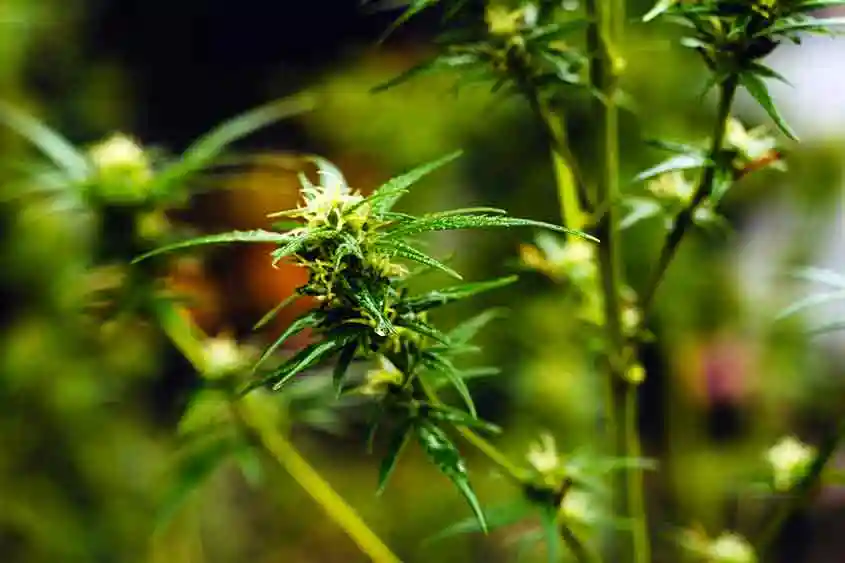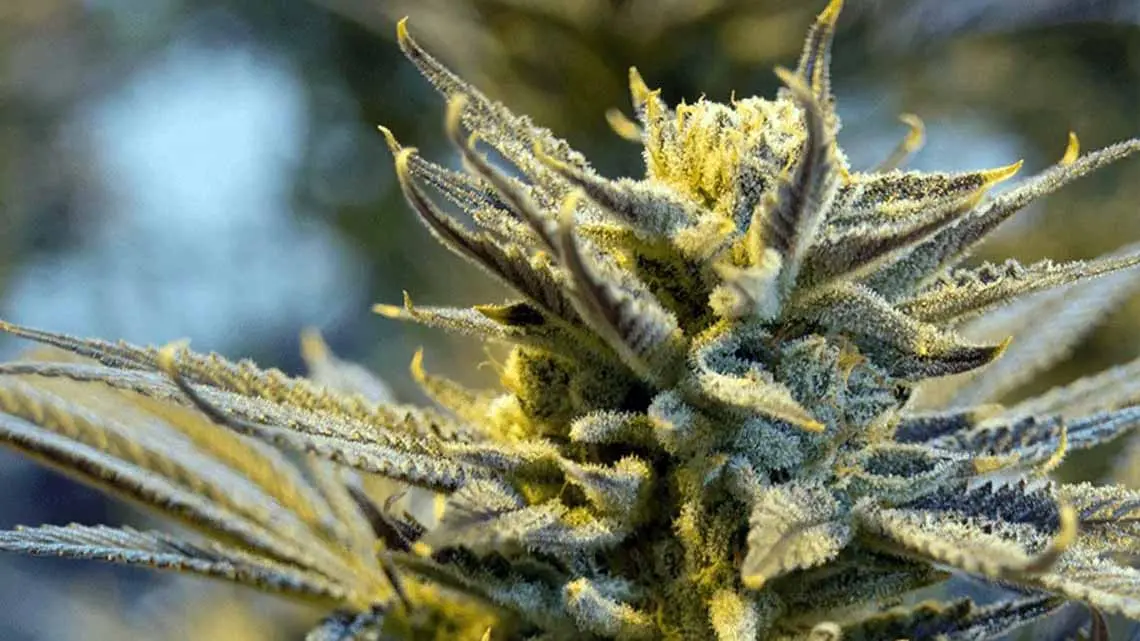Medical marijuana dispensaries offer a wide array of marijuana products, which can make it tricky for new customers to select the ideal products for them. You basic marijuana knowledge, including information about the two main types of marijuana strains—Cannabis Sativa and Cannabis Indica. This knowledge is essential in making informed choices.
Physical Appearance: Indica vs. Sativa
Cannabis Sativa
Cannabis sativa plants are notable for their height and slender build, making them distinct in the cannabis family. A closer look at their physical characteristics:
- Tall and Large: Sativa plants are typically tall, ranging from 5 to 18 feet. This towering structure makes them stand out, especially in outdoor growing environments.
- Skinny Build: Despite their height, sativa plants are relatively skinny and elegant.
- Leaves: The leaves of sativa plants are thin and pointed, resembling long, delicate fingers.
- Light Green Color: Sativa leaves usually have a lighter shade of green (compared to indica leaves), which can help distinguish between the two strains.
- Limited Branches: Sativa plants have fewer branches compared to indica plants. This limited branching results in a more open structure. This feature allows more light to penetrate the plant.
- Airy Appearance: The sparse branching and elongated leaves give sativa plants a more airy and less dense appearance. Also, this can be beneficial for air circulation and reduce the risk of mold and mildew.

Cannabis Indica
In contrast, cannabis indica plants have a shorter, bushier structure. These features make them well-suited for certain growing environments and provide distinctive visual cues.
- Short and Stocky: Indica plants typically grow between 2 to 4 feet tall. Their short stature makes them ideal for indoor growing, where space can be limited.
- Robust Build: Despite their shorter height, Indica plants have a robust, sturdy build. They often appear thick and resilient.
- Broad and Thick Leaves: The leaves of indica plants are broad and thick, with a wider surface area (compared to sativa leaves). This gives them a more substantial and hearty appearance.
- Dark Green Color: Indica leaves are usually darker, providing a visual contrast to the lighter green sativa leaves.
- Compact Branching: Indica plants feature more branches that grow closely together. This compact branching results in a denser, more bushy plant structure.
- Full Appearance: The close-knit branches and broader leaves give indica plants a fuller and more solid look. This also helps maximize yield in smaller growing spaces.
Growing Environments and Considerations
Understanding the physical differences between sativa and indica plants can help growers optimize their cultivation practices based on natural characteristics:
- Outdoor Preference: Due to their height and need for space, sativa plants thrive best in outdoor environments (where they have room to grow and stretch).
- Longer Flowering Time: Sativa plants typically have a longer flowering period (which means they require a longer growing season to reach maturity).
- Indoor Suitability: Indica plants are well-suited for indoor growing due to their compact size and dense branching. In other words, they are easier to manage in confined spaces.
- Shorter Flowering Time: Indica plants generally have a shorter flowering period. This allows for quicker harvest cycles and the potential for multiple harvests within a year.
By understanding these fundamental differences in physical appearance and growth characteristics, cultivators and consumers can make more informed decisions about which strain might best suit their needs and preferences.
Composition: THC vs. CBD in Indica and Sativa Strains
Understanding the chemical composition of cannabis strains is crucial for discerning their effects and therapeutic benefits. The main compounds in marijuana that produce its well-known effects are THC (tetrahydrocannabinol) and CBD (cannabidiol). Both sativa and indica plants contain THC and CBD but in varying quantities. A detailed look at these compounds and how they differ between sativa and indica strains.
Key Compounds in Cannabis
- THC (Tetrahydrocannabinol)
Psychoactive Component: THC is the primary psychoactive compound in cannabis, responsible for the ‘high’ sensation.
Effects: It binds to cannabinoid receptors in the brain. The resulting effects include euphoria, altered senses, and impaired memory and coordination.
Therapeutic Uses: THC is effective in pain relief, reducing nausea, and stimulating appetite. So, it is beneficial for conditions like chronic pain, cancer, and HIV/AIDS.
- CBD (Cannabidiol)
Non-Psychoactive: Unlike THC, CBD does not produce a high. It interacts with different receptors in the brain and body, offering various therapeutic benefits.
Effects: CBD is known for its calming, anti-inflammatory, and anti-anxiety properties.
Therapeutic Uses: It helps manage conditions like epilepsy, anxiety disorders, chronic pain, and inflammatory diseases.

Cannabis Sativa Composition
Cannabis sativa strains are typically characterized by their higher THC content compared to CBD.
- THC Dominance
Higher THC Levels: Sativa plants generally have a higher THC content, which contributes to their potent psychoactive effects.
Effects of Higher THC: This higher THC content makes sativa strains more stimulating and energizing, often used to enhance creativity, focus, and sociability.
Medical Applications: Sativa strains are often chosen for daytime use and for treating conditions like depression, ADHD, and fatigue due to their uplifting effects.
- Lower CBD Levels
Reduced CBD Presence: While sativa strains do contain CBD, it is usually in lower concentrations compared to THC.
Impact of Lower CBD: The reduced CBD levels mean that the therapeutic, non-psychoactive effects are less pronounced. This makes sativa strains less suitable for conditions requiring high CBD doses.
Cannabis Indica Composition
Cannabis indica strains are generally characterized by their higher CBD content compared to THC.
- CBD Dominance
Higher CBD Levels: Indica plants typically have a higher concentration of CBD, which provides numerous therapeutic benefits without the high.
Effects of Higher CBD: This higher CBD content makes indica strains more relaxing and sedative. Understandably, they are often used to alleviate anxiety, insomnia, and chronic pain.
Medical Applications: Indica strains are often chosen for nighttime use and for treating conditions like anxiety, muscle spasms, and sleep disorders due to their calming effects.
- Lower THC Levels
Reduced THC Presence: While indica strains do contain THC, it is usually in lower concentrations compared to CBD.
Impact of Lower THC: The reduced THC levels mean that the psychoactive effects are less intense. So, indica strains are a better choice for users seeking therapeutic benefits without significant psychoactivity.
Variability in THC and CBD Content
It’s important to note that these are generalizations, and the THC and CBD content can vary significantly within any cannabis plant species. Factors such as growing conditions, plant genetics, and cultivation techniques can influence the cannabinoid profile of a particular strain.
- Balanced THC and CBD: Many modern strains are hybrids, bred to have balanced levels of THC and CBD to combine the benefits of both compounds.
- Tailored Effects: These hybrids can be tailored to produce specific effects and are often used to target particular medical conditions more effectively.
Understanding the composition of THC and CBD in cannabis strains helps in selecting the right strain for specific needs. Sativa strains, with their higher THC content, are more suitable for daytime use and stimulating effects. On the other hand, Indica strains, with their higher CBD content, are better for relaxation and therapeutic use. Always consider the specific cannabinoid profile and consult with a healthcare professional to ensure the chosen strain aligns with your health requirements and goals.
How THC and CBD Work in the Body
The effects of cannabis on the human body are primarily attributed to its two main compounds: THC (tetrahydrocannabinol) and CBD (cannabidiol). As we’ve seen, these compounds interact with the body’s endocannabinoid system to produce a range of physical and psychological effects. Understanding how THC and CBD work can help users make informed choices about their cannabis consumption.

THC: The Psychoactive Compound
- Generation of the ‘High’: THC is well-known for its psychoactive properties, which are responsible for the ‘high’ associated with marijuana use. This high can vary in intensity based on the THC concentration and individual tolerance.
- Binding to CB1 Receptors: THC primarily binds to CB1 receptors in the brain, influencing neurotransmitter release and affecting various mental and physical functions.
- Pain Management: THC is effective in alleviating chronic pain by interacting with pain receptors in the nervous system.
- Euphoria and Mood Enhancement: The activation of CB1 receptors can result in feelings of euphoria and an overall enhancement of mood.
- Drowsiness: THC can induce drowsiness, making it useful for individuals struggling with insomnia or other sleep disorders.
- Impaired Movement and Perception: High doses of THC can lead to impaired motor skills and altered perception, affecting coordination and reaction time.
Potential side effects include:
- Anxiety and Paranoia: Some users may experience heightened anxiety or paranoia, especially with high doses of THC.
- Memory Impairment: THC can affect short-term memory, making it difficult to retain new information.
- Increased Heart Rate: Consumption of THC can lead to an increased heart rate, which might be problematic for individuals with heart conditions.
CBD: The Therapeutic Compound
- Lack of Intoxication: Unlike THC, CBD does not produce a high. It is non-psychoactive and offers therapeutic benefits without altering mental state.
- Interaction with CB2 Receptors: CBD primarily interacts with CB2 receptors found throughout the immune system, contributing to its anti-inflammatory and immunomodulatory effects.
- Prevention of Seizures: CBD is highly effective in reducing the frequency and severity of seizures, particularly in conditions like epilepsy.
- Anti-Inflammatory Properties: CBD reduces inflammation, making it beneficial for treating conditions such as arthritis and multiple sclerosis.
- Pain Relief: CBD can alleviate pain by reducing inflammation and interacting with pain receptors.
- Alleviation of Mental Health Symptoms: CBD is known to reduce symptoms of anxiety and depression, promoting a sense of calm and well-being.
Additional benefits include:
- Reduced Nausea: CBD can help in managing nausea and vomiting, particularly in patients undergoing chemotherapy.
- Lowering THC’s Intoxicating Effects: Research indicates that CBD can mitigate some of the intoxicating effects of THC, such as anxiety and paranoia, leading to a more balanced experience.
The Role of Other Compounds
Marijuana plants contain numerous other compounds that can influence their effects, including:
- Aromatic Compounds: Terpenes are responsible for the distinct aroma of cannabis. They are found in many plants and contribute to the overall experience of cannabis use.
- Modulation of Effects: Terpenes can interact with cannabinoids to enhance or modify their effects, a phenomenon known as the entourage effect. For example, myrcene is thought to enhance the relaxing effects of THC, while limonene may elevate mood.
Cannabigerol (CBG)
- Minor Cannabinoid: CBG is a non-psychoactive cannabinoid that is found in smaller quantities in cannabis plants.
- Potential Benefits: Early research suggests that CBG may have therapeutic potential for conditions such as glaucoma, inflammatory bowel disease, and bacterial infections.
Both THC and CBD interact with the body’s endocannabinoid system but produce different effects due to their distinct interactions with cannabinoid receptors. THC is primarily responsible for the psychoactive effects and offers benefits such as pain relief and mood enhancement, though it can also cause side effects like anxiety and memory impairment. In contrast, CBD provides therapeutic benefits without the high, helping with conditions like epilepsy, anxiety, and inflammation. Additionally, other compounds in marijuana, such as terpenes and CBG, also contribute to its overall effects.
How They Make You Feel: Indica vs. Sativa
The subjective effects of cannabis strains are a significant factor in their selection and use. While individual experiences can vary, there are general trends in how Cannabis sativa and Cannabis indica strains typically affect users. Here’s a deeper look into the feelings they commonly evoke.

Cannabis Sativa: Energetic and Uplifting
- Energetic High: Sativa strains are often associated with a stimulating and invigorating high. Users frequently report feeling more alert and mentally active.
- Increased Creativity: Many individuals find that sativa strains enhance creativity and help generate new ideas, making them popular among artists, writers, and musicians.
- Enhanced Focus: The uplifting effects of Sativa can improve focus and concentration, making these strains suitable for daytime use when tasks and productivity are a priority.
- Social and Mood-Enhancing
- Sociability: Sativa strains can promote sociability, making users more talkative and engaged in social interactions. This makes them a good choice for social gatherings and events.
- Elevated Mood: The euphoric effects of sativa strains can elevate mood and help alleviate symptoms of depression and anxiety, providing a sense of well-being and happiness.
Cannabis Indica: Calming and Relaxing
- Full-Body Relaxation: Indica strains are known for their deeply relaxing effects, which can lead to a state of calm and tranquility. Users often describe a feeling of physical heaviness and a “couch-lock” effect.
- Stress Relief: The calming properties of Indica strains are effective in reducing stress and promoting a sense of relaxation and peace.
- Sleep Aid: Due to their sedative effects, Indica strains are often used to combat insomnia and other sleep disorders, helping users fall asleep faster and enjoy more restful sleep.
- Pain Management: Indica strains are commonly used for their pain-relieving properties. They can help alleviate chronic pain, muscle spasms, and inflammation.
- Muscle Relaxation: The muscle-relaxant effects of Indica strains can help with conditions like multiple sclerosis and fibromyalgia.
Individual Variability and Research Needs
- Individual Differences: It’s important to note that individual responses to cannabis can vary widely. Factors such as tolerance, biology, and even mood at the time of consumption can influence the effects.
- Personal Preferences: Some users may prefer Sativa strains for their uplifting effects, while others might favor indica strains for their relaxing properties.
- Ongoing Studies: While these generalizations about the effects of Sativa and Indica strains are widely accepted, more scientific research is needed to fully understand the mechanisms behind these effects and to validate these broad assertions.
- Entourage Effect: Research is also exploring the entourage effect, where the combination of cannabinoids, terpenes, and other compounds in cannabis work together to produce unique effects. This complex interaction may further explain the varied experiences users report.
Understanding the general effects of Cannabis sativa and Cannabis indica can help users select strains that best suit their desired experience. Sativa strains are typically associated with an energetic and uplifting high, making them suitable for daytime use and social activities. In contrast, Indica strains are known for their calming and sedative effects, making them ideal for relaxation, stress relief, and nighttime use. However, individual experiences can vary, and ongoing research will continue to shed light on the nuanced effects of these cannabis strains.
Conclusion
Navigating the diverse offerings of medical marijuana dispensaries can be daunting, especially for new customers. A fundamental understanding of marijuana, particularly the differences between Cannabis sativa and Cannabis indica, can be immensely helpful. Sativa plants are tall and thin with higher THC content, providing an energizing and uplifting experience, ideal for daytime use and enhancing creativity and sociability. Indica plants, on the other hand, are shorter and bushier with higher CBD levels, known for their calming and sedative effects, making them suitable for nighttime use, stress relief, and pain management. Appearance and chemical composition aid in identifying and selecting the appropriate strains based on individual needs.
THC and CBD interact with the body’s systems but produce different effects. THC is psychoactive, offering euphoria and altered perception, good for pain management and appetite stimulation. On the other hand, CBD provides therapeutic benefits without the high, such as reducing seizures, inflammation, and anxiety. Additionally, other compounds in marijuana, like terpenes and cannabigerol (CBG), contribute to the overall effects experienced by users. Understanding these differences helps in making informed decisions about cannabis products. Always consult with a certified healthcare professional to ensure the chosen cannabis products align with your health requirements and goals, optimizing the cannabis experience.
Consult a healthcare professional before using cannabis products; the advice provided is not a substitute for medical guidance.

